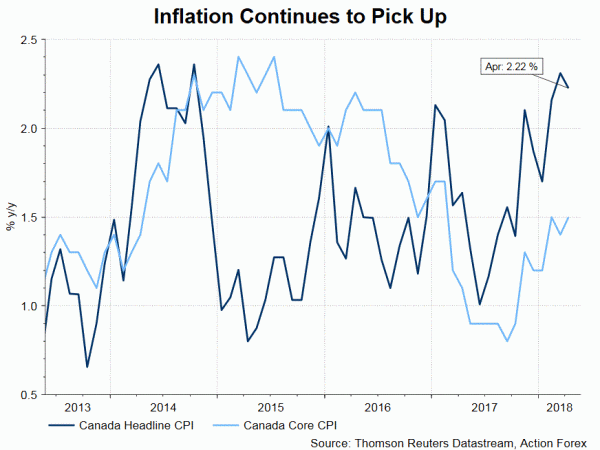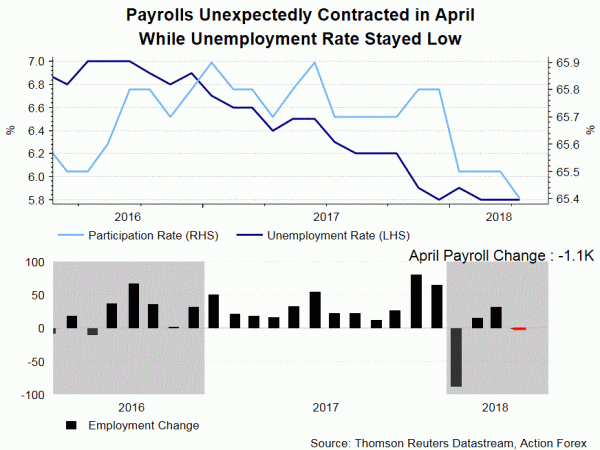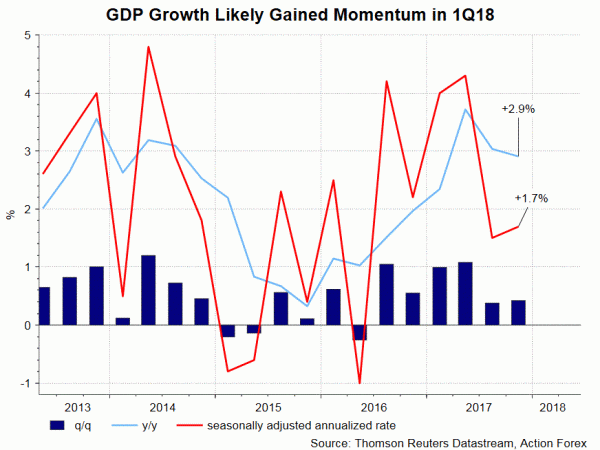Bank of Canada (BOC) would most likely leave its policy rate unchanged at 1.25% in May. Following two rate hikes in 2017 and one more in January this year, BOC has kept its powder dry since then. In April, the central bank cautiously noted that future monetary policy change would be “guided by incoming data” and directed by the future of trade policy.
Inflation Not as Dovish as Market Perceived
Inflation data April was a mixed bag. Headline CPI eased to +2.2% in April, from +2.3% a month ago. Expectations for a rate hike this month dropped sharply to 35% after the report, from 50% before that. Yet, we do not view the inflation report with dovish tone as the current level of inflation has stayed above the +2% target. Meanwhile, the average of the BOC’s three measures of core inflation, which exclude volatile components including oil prices, has just breached +2% for the first time since February 2012. We would not object a hike if the decision is just made based on this parameter alone.

April Payrolls Surprised to Downside
However, one would agree that it is prudent for BOC to remain cautious and wait for more clarity. The country’s employment market has been improving. However, payroll change in April was disappointing. Government data showed that the number of jobs surprisingly fell -1.1K last month, the second decline since mid-2016. The market had anticipated an increase of 20K. Indeed, at the Monetary Policy Report accompanying April’s policy announcement, BOC, while acknowledging absorption of excessive slack, reminded that “the long-term unemployment rate is still relatively high, the youth participation rate has room to increase” and “the oil- and gas-producing regions continue to point to remaining labour market slack”.

First Quarter GDP Growth Closely Watched
Released earlier this month, GDP expanded +0.4% m/m in February, compared with consensus of +0.3% and a contraction of -0.1% in January. The March, as well as the first quarter growth data, would be due May 31. The market expects a +0.2% m/m growth in March and an annualized growth rate of +1.9% for 1Q18, compared with +1.7% in the prior quarter. It would probably Should the data came in inline with expectations

Trade Policy Direction Highly Uncertain
Besides economic developments, what warrants vigilance is the highly uncertain direction of trade policy. Last Wednesday, the US suddenly announced to launch a national security investigation, under Section 232 of the Trade Expansion Act, into car and truck imports. This could lead to new US tariffs similar to those imposed on imported steel and aluminum in March. As US Commerce Secretary Wilbur Ross noted in a statement, “there is evidence suggesting that, for decades, imports from abroad have eroded our domestic auto industry”. Before the announcement, the White House noted that the move was partly aimed at pressuring Canada and Mexico to make concessions in talks to update the NAFTA, as well as pressuring Japan and the EU.
We do not expect NAFTA would be scrapped eventually. However, what and how much concession the parties involved would have to be made to secure is a contentious topic. It should cause much volatility in market sentiment and the financial markets, in particular Canadian dollar and yields.














